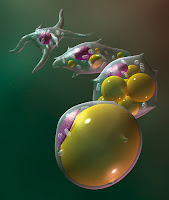Fat Storage Enzyme May Keep Fat Mice Healthy
 Obesity is often described as a state of low grade inflammation. Activated macrophages (white blood cells) in adipose tissue play an important role in this inflammatory response by secreting a number of pro-inflammatory molecules (cytokines) that can promote the development of insulin resistance and other complications of obesity.
Obesity is often described as a state of low grade inflammation. Activated macrophages (white blood cells) in adipose tissue play an important role in this inflammatory response by secreting a number of pro-inflammatory molecules (cytokines) that can promote the development of insulin resistance and other complications of obesity.
Previous studies have shown that the “glitazone” class of antidiabetic agents can suppress inflammatory macrophage activation and can also increase the expression of an DGAT1 (triacylglycerol (TG) synthesis enzyme acyl CoA:diacylglycerol acyltransferase 1), an enzyme that makes it easier for fat cells and macrophages to store excess fat.
Now a paper by Suneil Koliwad and colleagues from the Gladstone Institute of Cardiovascular Disease, University of California, San Francisco, CA, published in this weeks’ issue of the Journal of Clinical Investigation, provides further evidence that increasing activity of DGAT1 in adipocytes and macrophages may protect animals from the pro-inflammatory effects of obesity.
The researchers found that although mice overexpressing DGAT1 in both macrophages and adipocytes were more prone to weight gain, they did not show signs of the inflammatory response commonly seen with diet-induced obesity.
Through a series of experiments, the researchers were able to establish that DGAT1 is indeed necessary to protect against this inflammatory response, thereby raising the question of wether stimulation of this enzyme may also protect against the complications of obesity in humans.
Thus, although this research may not lead to new ways of preventing or reducing obesity, it may open new avenues for attenuating some of the health consequences related to excess weight.
AMS
Copenhagen, Denmark
Does Belly Fat Beget Belly Fat?
 Obesity is a chronic disease and it seems that the heavier you get, the easier it is to put on even more weight.
Obesity is a chronic disease and it seems that the heavier you get, the easier it is to put on even more weight.
I can think of many reasons why this may happen: less activity as you get heavier, more “emotional” eating, poorer sleep, to just name a few.
But here is a new idea: fat cells themselves may produce a substance that helps you grow even more fat cells.
This may indeed be the case, according to a study by Kaiping Yang and colleagues from the University of Western Ontario, London, Ontario published last month in the FASEB Journal.
The study was about Neuropeptide Y (NPY), a potent stimulator of hunger. Yang and colleagues not only found that in mouse and rat models of obesity, visceral fat cells can produce NPY, but also that NPY can promote the proliferation of adipocyte precursor cells via the Y1 receptor.
In fact NPY levels in visceral fat tissue were 6-fold higher in an early-life programmed rat model of increased visceral adiposity, but also more than 2-fold higher in visceral fat tissue of obese Zucker rats.
It turns out that at least in rodents, belly fat itself may be a risk factor for even more belly fat.
Would not surprise me if the same was true for humans.
An interesting question is whether or not the NPY made by fat cells can actually enter the brain to stimulate hunger, and thus, cause the animals (and humans?) to eat more – thereby creating a true vicious cycle.
Certainly an intriguing (although somewhat depressing) hypothesis.
AMS
Edmonton, Alberta
Googling Guggul for Weight Loss
Guggul, or rather guggulsterone, is the active ingredient in an age-old Indian Ayurvedic remedy derived from the gum resin of the guggul tree (Commiphora mukul), which has been shown to lower lipid and cholesterol levels. Claims have also been made regarding its usefulness as an antiobesity drug, although the data on this is far from consistent.
A recent paper by Yang and colleagues from the University of Georgia, published in a recent issue of OBESITY, demonstrates that guggelsterone in fact does substantially inhibit adipogenic differentiation of cultured 3T3-L1 cells (a widely used in vitro model of fat cells). In this model, guggulsterone also promotes lipolysis as well as induces apoptosis of fat cells, albeit at higher concentrations. (link to abstract)
Together, these findings appear to provide a biological mechanism to support the anti-obesity health claims for this compound.
However, this does not mean that we now have a new natural “solution” to the obesity problem (although, as a brief excursion to Google confirms, guggul is already widely promoted and available for exactly that).
Here are my reservations:
1) Fat cells are the safest place to store excess calories. Limiting the growth or destroying fat cells, without also targeting the state of caloric excess raises the issue of where those extra calories should go. Because they are in excess of what the body needs, they are not simply “burnt off”. Rather, the body now has to store them somewhere else, i.e. in non-fat tissue (for e.g. liver, muscle, etc.) – also referred to as “ectopic” fat deposition. There is now ample evidence that it is in fact this ectopic fat that causes the metabolic problems (e.g. diabetes) that are often associated with obesity. So if guggul prevents the formation of fat cells or destroys them (by apoptosis) the big question is: what happens with all the excess energy? If this now ends up in the form of fat stores in other organs like your liver or muscle, you are more likely to cause harm rather than reap any benefits.
2) Obviously, extrapolating from an in vitro finding to clinical benefits in patients is a long shot. While the data on guggul’s clinical antilipid effects appears well-documented, I am not convinced of any weight-loss effects thus far. Destroying fat cells, to me does not necessarily translate into weight loss unless the extra calories stored in those cells are actually burnt. For that guggul would either have to promote burning of calories, for which to my knowledge there is no indication. Alternatively, guggul would have to also reduce energy intake for which I have also seen no evidence.
The bottom line is that, despite this elegant laboratory work demonstrating biological action of guggelsterone in vivo, health claims should be based on demonstration of clinically significant health benefits in rigorously conducted clinical trials. As the issue in obesity treatment is not short-term weight loss but rather long-term weight-loss maintenance, these studies would have to be long enough (i.e. 12 months or longer).
Is this going to stop people from selling and buying guggul because of its now “proven ability to destroy fat cells”?
Not likely.
Will I be recommending guggulsterone as obesity treatment to my patients?
Definitely not!
AMS


